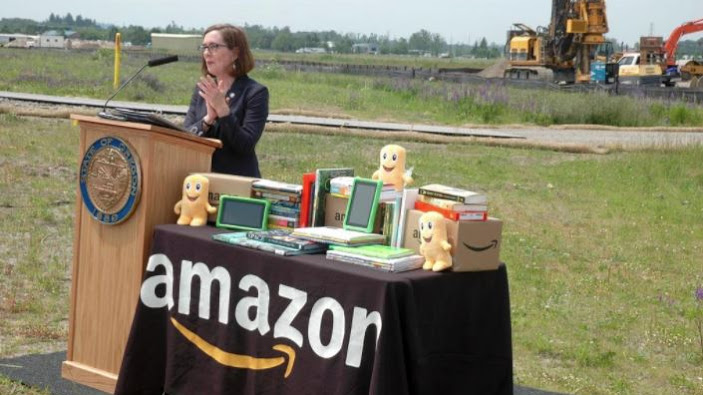Amazon.com Inc.'s (NASDAQ: AMZN) presence in Oregon has expanded significantly in just the past year.
The company opened its first sortation center in the state back in 2016, hiring more than 1,000 workers in Hillsboro. This year alone, Amazon has announced plans to hire another 3,000-plus workers over the next year at new fulfillment centers in Troutdale, Salem and Portland.
To top that off, the company has also announced plans to develop a five-building data center near Hermiston that, at full build-out, would employ about 100 people and represent an investment of some $2.75 billion, according to Business Oregon, the state's economic development arm.
But along with Amazon’s rising number of workers and facilities throughout the Beaver State comes another numerical set: the millions in tax breaks that the company is enjoying as a result of its investment here.
In fact, at $213.1 million, Oregon has given or promised more in tax breaks to Amazon than any other state in the country.
According to public records, Amazon will receive tax abatements through the state’s Enterprise Zone program worth $13.2 million for its facilities in Troutdale and Salem; the company has also applied for that program for its Portland and Hillsboro sites. And out in Hermiston, the new data center, if it is fully developed as proposed, could result in a tax benefit to Amazon of $176 million through the state's Strategic Investment Program.
“They are absolutely great neighbors,” said Paul Chalmers, director of assessment and tax for Umatilla County. “They provide family-wage jobs, and for the size of the investment they are placing in Umatilla County . . . it’s going to make a tremendous impact.”
The Amazon Effect: Our full coverage
- How taxpayers are funding the disruption of the U.S. economy
- Mr. Bezos goes to Washington
- Tracking Amazon's rapidly growing footprint
Amazon, whose data center arm is an entity called Vadata Inc., already employs about 130 people at its existing Eastern Oregon data center sites, which combined also received tax breaks worth about $24 million. The 100 jobs at the proposed new site near Hermiston would pay about $70,000 a year.
And while that may not be a huge number of jobs, Chalmers said the tax breaks Amazon gets in return for its new investments more than pay off. One major way: the increase in property values added to the county’s tax rolls once the Enterprise Zone exemptions expire on Amazon’s investments. Chalmers said the total taxable property value in Umatilla County at present is $5.7 billion.
“So you can imagine what another $2.5 billion is going to do,” he said. “It has a pretty significant impact.”
But others aren’t so sure that Oregon should be giving away anything to Amazon for operations like fulfillment and data centers.
“Incentives don’t make sense when they are already wanting to build here anyway,” said Chuck Sheketoff, executive director of the Oregon Center for Public Policy. “It’s our geography they want, not our tax breaks, but they’re getting those too.”
Giving up property taxes takes money away from public schools and other services, he said, and Amazon doesn’t have huge sales in Oregon, so “we are not getting much income tax out of them.”
Sheketoff also said that giving Amazon essentially $1.76 million per job created in the new data center site in Hermiston — in the form of tax abatement — isn’t much of a deal. (The company's tax break would be even larger in Hermiston, but the SIP requires community service fees and other payments of about $67.5 million over 15 years.)
In addition, he said, giving away the money in advance and expecting to get it back when the tax exemptions expire and the property joins the tax rolls can be a little like rolling the dice. Sheketoff said companies like Intel often seem to have their tax breaks extended with the promise of more new investment, and there’s always the chance that Amazon’s data centers could be mothballed or never come to fruition at all.
“The issue is, How much are you losing today?” Sheketoff said. “It’s like the logic that you went to Costco and saved $100 — but honey, you spent $500. You are giving up all this money to get it down the line. It’s goofy math.”
But Nathan Buehler, marketing and communications manager for Business Oregon, noted that no one is giving Amazon any up-front cash incentives, grants or loans. What the company is taking advantage of, he said, are property tax programs that have been set up to help offset large investments in very rural areas. And rather than losing any money, local communities benefit from the property taxes and fees that are being paid on an investment that didn’t exist before.
“There was not an industrial user of that land before Amazon came in. They are building a facility far outside any metro area in very rural eastern Oregon, paying property tax on land and the first $25 million investment, paying the community service fee and participating as a community partner,” he said. “There is nothing the region is giving up. The region gains millions in new revenue. That investment isn’t happening but for the use of this program in concert with the advantages of the site.”
This story was updated to include input from Nathan Buehler of Business Oregon


